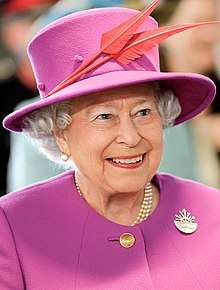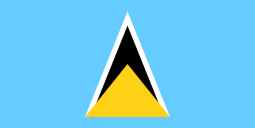Monarchy of Saint Lucia
The monarchy of Saint Lucia is a system of government in which a hereditary, constitutional monarch is the sovereign and head of state of Saint Lucia. The present monarch of Saint Lucia is Elizabeth II, who is also the Sovereign of the Commonwealth realms. The Queen's constitutional roles are mostly delegated to the Governor-General of Saint Lucia.
| Queen of Saint Lucia | |
|---|---|
 | |
| Incumbent | |
 | |
| Elizabeth II | |
| Details | |
| Style | Her Majesty |
| Heir apparent | Charles, Prince of Wales |
| First monarch | Elizabeth II |
| Formation | 22 February 1979 |
 |
|---|
| This article is part of a series on the politics and government of Saint Lucia |
|
Legislative
|
|
| Administrative divisions (Quarters) |
|
|
Royal succession is governed by the English Act of Settlement of 1701, which is part of constitutional law.
Queen Elizabeth II has reigned since independence on 22 February 1979. She along with her husband and other members of the Royal Family undertake various official, ceremonial and representational duties.
International and domestic role
Fifty-two states are members of the Commonwealth of Nations. Sixteen of these countries are specifically Commonwealth realms who recognise, individually, the same person as their Monarch and Head of State; Saint Lucia is one of these. Despite sharing the same person as their respective national monarch, each of the Commonwealth realms – including Saint Lucia – is sovereign and independent of the others.
As a constitutional monarch Queen Elizabeth II relies entirely on the advice of her Saint Lucian ministers. The monarch is briefed by regular communication for her Saint Lucian government. Most of the Queen's daily constitutional roles are mostly delegated to the Governor-General of Saint Lucia.[1]
[2] The governor general is appointed entirely upon the advice of her Saint Lucian government. The monarch maintains direct contact with the governor general. The present Governor-General is His Excellency Sir Emmanuel Neville Cenac GCMG.[3]
Development of the monarchy
Control of St Lucia was disputed between the British and French from 1659 until 1814 when it was ceded to the British.[4]
The Balfour Declaration of 1926 provided the dominions the right to be considered equal to Britain, rather than subordinate; an agreement that had the result of, in theory, a shared Crown that operates independently in each realm rather than a unitary British Crown under which all the dominions were secondary. The Monarchy thus ceased to be an exclusively British institution, although it has often been called "British" since this time (in both legal and common language) for reasons historical, legal, and of convenience. The Royal and Parliamentary Titles Act, 1927 was the first indication of this shift in law, further elaborated in the Statute of Westminster, 1931.
Under the Statute of Westminster, Saint Lucia has a common monarchy with Britain and the other Commonwealth realms, and though laws governing the line of succession to the Saint Lucian throne lie within the control of the Saint Lucian Parliament, Saint Lucia cannot change the rules of succession without the unanimous consent of the other realms, unless explicitly leaving the shared monarchy relationship by means of a constitutional amendment. This situation applies symmetrically in all the other realms, including the UK.
The island became self-governing in 1967 and achieved independence in 1979.[5]
Title
In Saint Lucia, the Queen's official title is: Elizabeth the Second, by the Grace of God, Queen of Saint Lucia and of Her other Realms and Territories, Head of the Commonwealth.[6]
This style communicates Saint Lucia's status as an independent monarchy, highlighting the Monarch's role specifically as Queen of Saint Lucia, as well as the shared aspect of the Crown throughout the realms. Typically, the Sovereign is styled "Queen of Saint Lucia," and is addressed as such when in Saint Lucia, or performing duties on behalf of Saint Lucia abroad.
Duties
Most of the Queen's domestic duties are performed by the Governor General. The Governor-General represents the Queen on ceremonial occasions such as the opening of Parliament, the presentation of honours and military parades. Under the Constitution, he is given authority to act in some matters, for example in appointing and disciplining officers of the civil service, in proroguing Parliament. As in the other Commonwealth realms, however, the Monarch's role, and thereby the vice-regent's role, is almost entirely symbolic and cultural, acting as a symbol of the legal authority under which all governments operate, and the powers that are constitutionally hers are exercised almost wholly upon the advice of the Cabinet, made up of Ministers of the Crown. It has been said since the death of Queen Anne in 1714, the last monarch to head the British cabinet, that the monarch "reigns" but does not "rule". In exceptional circumstances, however, the Monarch or vice-regal can act against such advice based upon his or her reserve powers.
There are also a few duties which must be specifically performed by, or bills that require assent by the Queen. These include: signing the appointment papers of Governors General, the confirmation of awards of honours, and approving any change in her title.
It is also possible that if the Governor General decided to go against the Prime Minister's or the government's advice, the Prime Minister could appeal directly to the Monarch, or even recommend that the Monarch dismiss the Governor General.
Succession
Succession to the throne was by male-preference primogeniture, and governed by the provisions of the Act of Settlement, as well as the English Bill of Rights. These documents, though originally passed by the Parliament of England, are now part of the Saint Lucian constitutional law, under control of the Saint Lucian parliament only. In agreement with the other Commonwealth Realms, Saint Lucia changed to absolute primogeniture in 2011 at the Perth Agreement.
This legislation lays out the rules that the Monarch cannot be a Roman Catholic, nor married to one, and must be in communion with the Church of England upon ascending the throne. As Saint Lucia's laws governing succession are currently identical to those of the United Kingdom (by the Statute of Westminster) see Succession to the British Throne for more information.
The heir apparent is Elizabeth II's eldest son, Charles, who has no official title outside of the UK, but is accorded his UK title, Prince of Wales, as a courtesy title.
Legal role
All laws in Saint Lucia are enacted with the sovereign's, or the vice-regal's signature. The granting of a signature to a bill is known as Royal Assent; it and proclamation are required for all acts of Parliament, usually granted or withheld by the Governor General. The Vice-Regals may reserve a bill for the Monarch's pleasure, that is to say, allow the Monarch to make a personal decision on the bill. The Monarch has the power to disallow a bill (within a time limit specified by the constitution).
The Sovereign is deemed the "fount of justice," and is responsible for rendering justice for all subjects. The Sovereign does not personally rule in judicial cases; instead, judicial functions are performed in his or her name. The common law holds that the Sovereign "can do no wrong"; the monarch cannot be prosecuted in his or her own courts for criminal offences. Civil lawsuits against the Crown in its public capacity (that is, lawsuits against the government) are permitted; however, lawsuits against the Monarch personally are not cognizable. The Sovereign, and by extension the Governor General, also exercises the "prerogative of mercy," and may pardon offences against the Crown. Pardons may be awarded before, during, or after a trial.
In Saint Lucia the legal personality of the State is referred to as "Her Majesty the Queen in Right of Saint Lucia." For example, if a lawsuit is filed against the government, the respondent is formally described as Her Majesty the Queen in Right of Saint Lucia. The monarch as an individual takes no more role in such an affair than in any other business of government.
Royal presence
Elizabeth II first visited Saint Lucia as part of her Caribbean tour of 1966. During her visit she opened the new Winban Research Centre. The Queen and the Duke of Edinburgh travelled on HMY Britannia. They were treated to traditional Saint Lucian Dances and a firework display. In 1985 The Queen and Duke returned to Saint Lucia: The Queen laid the foundation stone for the new Red Cross headquarters and visited residential homes for the elderly and schools.
Other members have also visited Saint Lucia: In 1979 Princess Alexandra, The Honourable Lady Ogilvy represented the royal family during the official independence celebrations. The Prince of Wales visited in 1989 to commemorate the tenth anniversary of these celebrations.[7] In 2012, the Earl and Countess of Wessex, were part of independence anniversary celebrations.[8]
References
- "The Executive". The Government of Saint Lucia. Archived from the original on 11 March 2009. Retrieved 28 February 2009.
- "Office of the Governor General". The Government of Saint Lucia. Archived from the original on 28 April 2012. Retrieved 28 February 2009.
- "The Queen's role in Saint Lucia". The British Monarchy. Retrieved 28 February 2009.
- "Home: The Queen and the Commonwealth: Queen and St Lucia: History and present government". The British Monarchy. Retrieved 28 February 2009.
- "Saint Lucia (island)". Encyclopædia Britannica. Retrieved 28 February 2009.
- "Home: The Queen and the Commonwealth: Queen and St Lucia". The British Monarchy. Retrieved 28 February 2009.
- "Home: The Queen and the Commonwealth: Queen and St Lucia: Royal Visits". The British Monarchy. Retrieved 28 February 2009.
- "The Earl and The Countess of Wessex tour the West Indies, 14 February 2012". The British Monarchy. Retrieved 6 May 2012.
See also
- Figurehead
- Prime Ministers of Queen Elizabeth II
- List of Commonwealth visits made by Queen Elizabeth II
- Monarchies in the Americas
- List of monarchies
